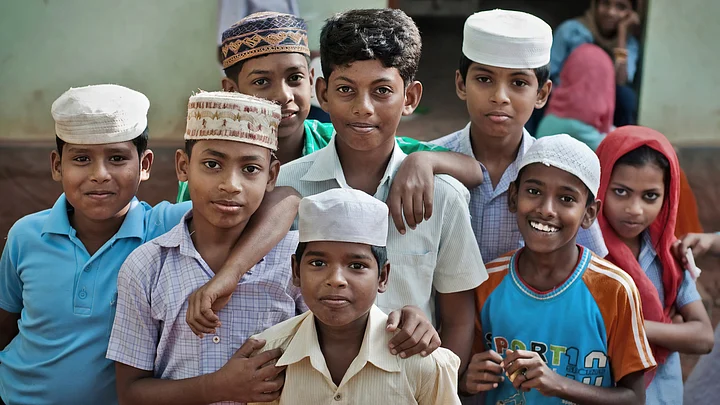That Muslims are growing at a faster rate than Hindus in independent India is old news. It has remained so since 1951. In the decade 1951-1961 Muslims grew at 24.9% while Hindus grew at 18.6%. In 1961-71, they grew at 32.49% and 20.76% respectively; during 71-81 this figure was 30.92% and 23.68%; in between 81-91 it was 3.78% and 24.07% respectively.
Nevertheless the notion that the Muslims are swamping the Hindus is quite ridiculous. The simple fact is that far from present trends continuing, population growth of all groups will cease by about the end of this century. A back-of-the-envelope calculation suggests that even if present trends continued it would take about 247 years for Muslims to catch up with Hindus in terms of numbers. But this does not mean there are no societal and sectarian attitudes that don’t impinge on the growth rates of these communities.
Population Jump in BIMARU Belt
Most of the demographer project that India’s population growth will taper off around 2060. But the growth of population in the BIMARU belt will continue to increase till 2091. The Muslim growth will also level off about then, by which time they will constitute a good 18.8% of India.
Given its political implication, this could be a matter of concern in some quarters. But what should equally be a matter of concern is the consequent implication that if the BIMARU population keeps growing till near the end of the century, then the population in other regions will actually be contracting. This may have even graver political consequences.
There are other trends, some disquieting, also visible now. The foremost of these is the sharp increase in the number of agricultural labourers. This is the classification reserved for “the poorest of the poor.” Their number has risen to 106.8 million in 2001 posting a decadal growth of 30.13%, a steep jump from the 19.03% of the previous decade. It has however, showed signs of abating in the second of the last decade when it declined in absolute terms during 2005 -2010 at a rate of 1.65 per cent per annum. Despite this, it is a severe indictment of the policies pursued in the decade after the so-called liberalisation.
Statistics Tell A Different Tale
- While India’s population will taper off around 2060, population growth in BIMARU states a matter of concern
- Household annual incomes of Muslims lower than the SC/ST segment
- More Hindu women employed today than their Muslim counterparts
- Muslims fare better when it comes to open defecation
- Prevalence of open defecation particularly high among Hindus
Other Comparisons
If economic conditions determine population growth, we must wonder as to why the growth of the SC and ST segment has remained below the Muslim growth trend? As opposed to the 29.3% decadal growth of Muslims in 1991–2001, the decadal growth rate of SCs and STs was 20.55% and 24.45% respectively. The household annual income as well as the incomes of the SC and ST groups must be somewhat lower than that of Muslims considering that among SCs 62.0% are casual labourers, while it is 45.2% and 42.9% for STs and Muslims respectively.
Muslims in turn are generally poorer than caste Hindus. Quite clearly there are segmental attitudes impacting population growth. Literacy levels of both rural and urban Muslims are lower than Hindus, but not quite much. Perhaps what is more significant is that as a percentage, more than twice as many uneducated Hindu women – 44% to 18% – are employed than similarly disadvantaged Muslim women.
The plight of rural Muslims is not very dissimilar to that of rural Hindus. As a percentage, more rural Hindu households (51.2%) are landless than rural Muslim households (39.5%). But when it comes to larger holdings of over one hectare, the incidence of Muslims household with land is over twice that of Hindus. For instance in the 1–2 ha segment, 11.7% of rural Muslim households fall into this category while it is only 6% for Hindus. Even so the difference between the average rural Muslim and Hindu by household monthly per capita expenditure remains about the same with Rs 833 and Rs 888 respectively.
Where Muslims Fare Better
But there is one area where Muslims fare much better. More than half of the Indian population, over 600 million people, defecate in the open, without the use of a latrine or toilet. The prevalence of open defecation (hereafter OD) is particularly high among Hindus. Data from the most recent wave of the National Health and Family Survey of India show that as of 2005, 67% of Hindu households defecate in the open – e.g. in fields, near streets, or behind bushes. In comparison, only 42% of the relatively poor Muslim households do so.
This is not without consequences on population growth. In India, Muslim children are substantially more likely than Hindu children to survive till their fifth birthday, despite Muslim parents being poorer and less educated on an average than Hindu parents. This phenomenon, which has been well documented and reveals that by age five, mortality among Muslims is about 18 per cent lower than among Hindus, with an additional 1.7 children per 100 surviving till the age of 5. How Hindu population growth shapes up also depends on how many of them take to the Prime Minister’s Swachch Bharat campaign to build more toilets and encourage its use.
(The author is chairman and founder of Centre for Policy Alternatives)
(At The Quint, we question everything. Play an active role in shaping our journalism by becoming a member today.)
